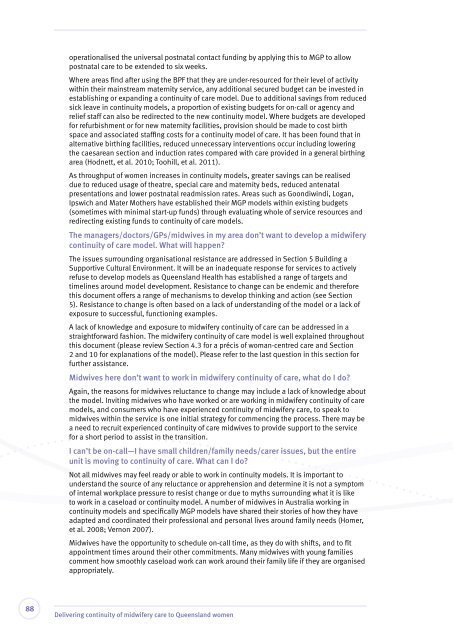Delivering continuity of midwifery care to Queensland women
Delivering continuity of midwifery care to Queensland women
Delivering continuity of midwifery care to Queensland women
Create successful ePaper yourself
Turn your PDF publications into a flip-book with our unique Google optimized e-Paper software.
operationalised the universal postnatal contact funding by applying this <strong>to</strong> MGP <strong>to</strong> allow<br />
postnatal <strong>care</strong> <strong>to</strong> be extended <strong>to</strong> six weeks.<br />
Where areas find after using the BPF that they are under-resourced for their level <strong>of</strong> activity<br />
within their mainstream maternity service, any additional secured budget can be invested in<br />
establishing or expanding a <strong>continuity</strong> <strong>of</strong> <strong>care</strong> model. Due <strong>to</strong> additional savings from reduced<br />
sick leave in <strong>continuity</strong> models, a proportion <strong>of</strong> existing budgets for on-call or agency and<br />
relief staff can also be redirected <strong>to</strong> the new <strong>continuity</strong> model. Where budgets are developed<br />
for refurbishment or for new maternity facilities, provision should be made <strong>to</strong> cost birth<br />
space and associated staffing costs for a <strong>continuity</strong> model <strong>of</strong> <strong>care</strong>. It has been found that in<br />
alternative birthing facilities, reduced unnecessary interventions occur including lowering<br />
the caesarean section and induction rates compared with <strong>care</strong> provided in a general birthing<br />
area (Hodnett, et al. 2010; Toohill, et al. 2011).<br />
As throughput <strong>of</strong> <strong>women</strong> increases in <strong>continuity</strong> models, greater savings can be realised<br />
due <strong>to</strong> reduced usage <strong>of</strong> theatre, special <strong>care</strong> and maternity beds, reduced antenatal<br />
presentations and lower postnatal readmission rates. Areas such as Goondiwindi, Logan,<br />
Ipswich and Mater Mothers have established their MGP models within existing budgets<br />
(sometimes with minimal start-up funds) through evaluating whole <strong>of</strong> service resources and<br />
redirecting existing funds <strong>to</strong> <strong>continuity</strong> <strong>of</strong> <strong>care</strong> models.<br />
The managers/doc<strong>to</strong>rs/GPs/midwives in my area don’t want <strong>to</strong> develop a <strong>midwifery</strong><br />
<strong>continuity</strong> <strong>of</strong> <strong>care</strong> model. What will happen<br />
The issues surrounding organisational resistance are addressed in Section 5 Building a<br />
Supportive Cultural Environment. It will be an inadequate response for services <strong>to</strong> actively<br />
refuse <strong>to</strong> develop models as <strong>Queensland</strong> Health has established a range <strong>of</strong> targets and<br />
timelines around model development. Resistance <strong>to</strong> change can be endemic and therefore<br />
this document <strong>of</strong>fers a range <strong>of</strong> mechanisms <strong>to</strong> develop thinking and action (see Section<br />
5). Resistance <strong>to</strong> change is <strong>of</strong>ten based on a lack <strong>of</strong> understanding <strong>of</strong> the model or a lack <strong>of</strong><br />
exposure <strong>to</strong> successful, functioning examples.<br />
A lack <strong>of</strong> knowledge and exposure <strong>to</strong> <strong>midwifery</strong> <strong>continuity</strong> <strong>of</strong> <strong>care</strong> can be addressed in a<br />
straightforward fashion. The <strong>midwifery</strong> <strong>continuity</strong> <strong>of</strong> <strong>care</strong> model is well explained throughout<br />
this document (please review Section 4.3 for a précis <strong>of</strong> woman-centred <strong>care</strong> and Section<br />
2 and 10 for explanations <strong>of</strong> the model). Please refer <strong>to</strong> the last question in this section for<br />
further assistance.<br />
Midwives here don’t want <strong>to</strong> work in <strong>midwifery</strong> <strong>continuity</strong> <strong>of</strong> <strong>care</strong>, what do I do<br />
Again, the reasons for midwives reluctance <strong>to</strong> change may include a lack <strong>of</strong> knowledge about<br />
the model. Inviting midwives who have worked or are working in <strong>midwifery</strong> <strong>continuity</strong> <strong>of</strong> <strong>care</strong><br />
models, and consumers who have experienced <strong>continuity</strong> <strong>of</strong> <strong>midwifery</strong> <strong>care</strong>, <strong>to</strong> speak <strong>to</strong><br />
midwives within the service is one initial strategy for commencing the process. There may be<br />
a need <strong>to</strong> recruit experienced <strong>continuity</strong> <strong>of</strong> <strong>care</strong> midwives <strong>to</strong> provide support <strong>to</strong> the service<br />
for a short period <strong>to</strong> assist in the transition.<br />
I can’t be on-call—I have small children/family needs/<strong>care</strong>r issues, but the entire<br />
unit is moving <strong>to</strong> <strong>continuity</strong> <strong>of</strong> <strong>care</strong>. What can I do<br />
Not all midwives may feel ready or able <strong>to</strong> work in <strong>continuity</strong> models. It is important <strong>to</strong><br />
understand the source <strong>of</strong> any reluctance or apprehension and determine it is not a symp<strong>to</strong>m<br />
<strong>of</strong> internal workplace pressure <strong>to</strong> resist change or due <strong>to</strong> myths surrounding what it is like<br />
<strong>to</strong> work in a caseload or <strong>continuity</strong> model. A number <strong>of</strong> midwives in Australia working in<br />
<strong>continuity</strong> models and specifically MGP models have shared their s<strong>to</strong>ries <strong>of</strong> how they have<br />
adapted and coordinated their pr<strong>of</strong>essional and personal lives around family needs (Homer,<br />
et al. 2008; Vernon 2007).<br />
Midwives have the opportunity <strong>to</strong> schedule on-call time, as they do with shifts, and <strong>to</strong> fit<br />
appointment times around their other commitments. Many midwives with young families<br />
comment how smoothly caseload work can work around their family life if they are organised<br />
appropriately.<br />
88<br />
<strong>Delivering</strong> <strong>continuity</strong> <strong>of</strong> <strong>midwifery</strong> <strong>care</strong> <strong>to</strong> <strong>Queensland</strong> <strong>women</strong>
















